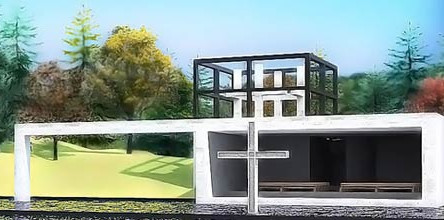
THEORIES OF ARCHITECTURE DESIGN

A leaf unfolds, its parts self-assembling from a slurry of nutrients, using ancient blueprints encoded on a molecular level to spread into a photosynthesizing, thermal regulating, pest-resistant and water-repelling surface. Nature can be something that inspire us of the design. And most of the time, it is. Before I get involve into architecture life, I was once wondering, who is the very first architect in the world, why will he will think to build something to live in it instead of just stay in the cave where naturally existed? What gives the inspiration? And how?
Few minutes later, this picture exists in my mind.

Nature is a very important element related to architecture. No matter the traditional architecture or contemporary architecture. As mentioned in last article, building should be built by following the site context, and “nature”, is one of the sub-element under site context, which includes the site’s climate, geology, soil condition, wind direction etc. Building should built by following the environmental factors in order to make sure the building is safe and sustainable even without the use of electricity.
However, nature is not all about it. It also can act as a buffer zone to a building, to block noise and dirt, provide privacy, and produce fresh air, humidity, create a calmer environment.
For this topic, I would like to take 3 building of Architect Tadao Ando as my case study.
1. Church of Light
2. Church of Wind
3. Church on Water
Church of Light



Everyone knows what make this building so special about, no doubt, is the void of cross that allow nature light comes through the interior of the building. Tadao Ando place the cross on the east façade in purpose to allows for light to pour into the space throughout the early morning until the day, which effect the interior concrete wall transforming the dark volume into an illuminated box.
Church of Light loacated In the small town of Ibaraki, outside of Osaka, Japan,. Its is one of the tadao Ando’s signature architectural works,
The Chapel consists of a rectangular volume of three cubes that are punctured by a wall at a fifteen degree angle that never actually touches the other walls or ceiling of the chapel. The geometry is nothing more than six walls and a roof, a minimalist end point that requires a thoughtful process that is able to eliminate anything else that is not relevant. This church is a simple building that makes the most of what it can, a testament to the phrase “less is more”.

Church of Wind

The Church of Light embraces his framework between nature and architecture through the way in which the sun light can act as a division and creates new spatial perceptions equally. The Church of Light is an architecture duality, which means the dual nature existence which includes solid vs void, stark vs serene and light vs dark. This building has no any ornamentation to beautify it, he use the nature light as the ornamentation instead. The intersection of light and the concrete wall enhances the visitor awareness of the spiritual and secular within themselves.
This small chapel located on Mount Rokko, near Kobe, completes the trilogy of Christian religious facilities designed by Tadao Ando in the mid-eighties. While not enjoying the same fame as the Church on the Water or the Church of Light, the chapel at Mount Rokko becomes a synthesis of its predecessors and stresses the architect’s effort to establish a link between the religious space and nature.
In this chapel Ando uses his usual vocabulary: simple geometry, the meticulously studied and delicate play of light and shadows, as well as the modulated exposed concrete surfaces that dialogue with the metal and glass.


Church of Wind is amlmost a square corete volume that is flanked by an adjoining vertical bell tower and a tunnel of translucent glass.To access the chapel one enters from a back exit of the hotel, past a small pond and into a long tunnel of frosted glass which is flooded with a milky white light. The end of the tunnel is open with a view of nature, but no sign of a chapel.
The reason why he built a tunnel as the entrance of the chapel is because he want every visitors to pass through it before entering the building, as there will be wind passing through the tunnel throughout the year base on his site investigation. It is like representing the sin of every visitor will be cleaned off before them entering the chapel by following the wind.
Church on Water

The church is located near Tomamu in the heart of the island of Hokkaido, northern Japan.
The visual focus of the church is directed to toward a grove of beech trees located in front of the temple in which a brook runs.

Same as the two above case study, it devoid of any excessive manmade ornamentation, many of the works of Tadao Ando base their wealth in building the relationship with nature. Well, the Church on the water no doubt is one of its most successful achievements which represented nature as an element involved in the design.


The most notable is that Ando has replaced the front wall of the temple, which usually have pictures of a certain divine religious significance, with a transparent glass of the Creator: nature itself. This will provide a live scene, multicoloured and always changing, which runs from pallets sepias in autumn, glaucos shades of winter, spring flowers spots in the intense green in summer. This is also another design idea of Tadao Ando which amaze me a lot too .
